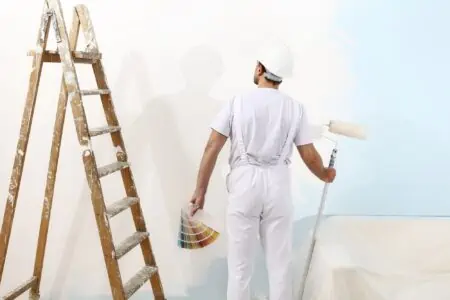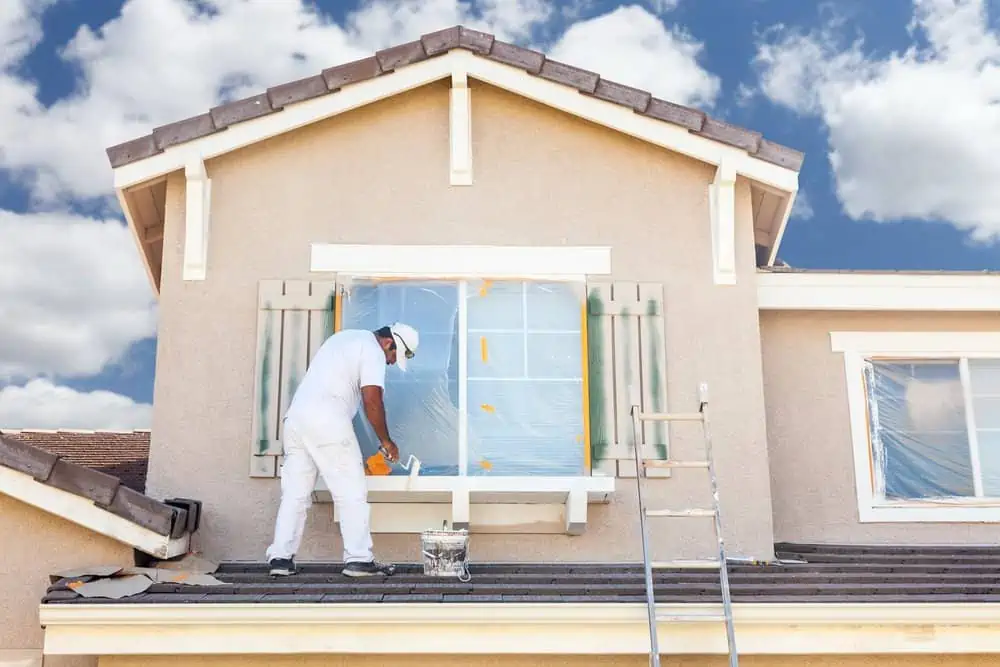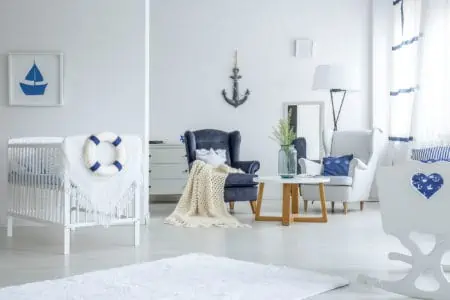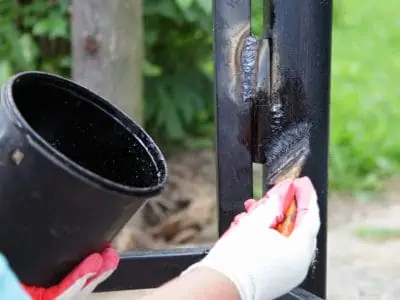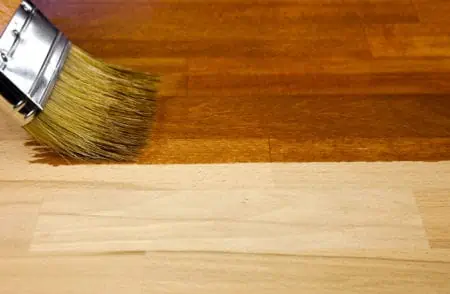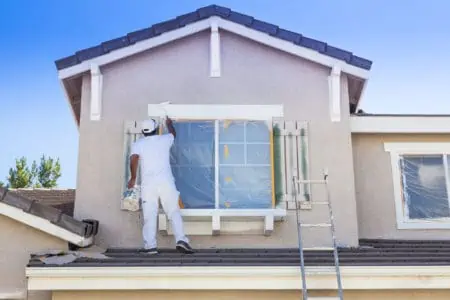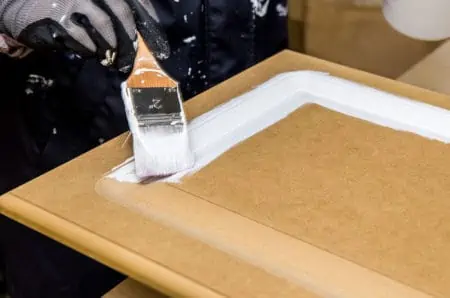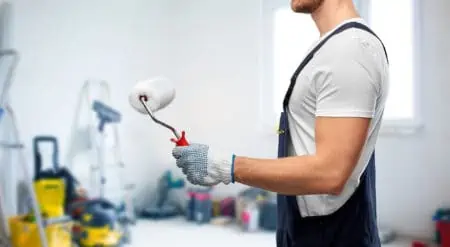Painting is one of the most popular DIY projects we can perform when it comes to home improvements. And it has so many physiological advantages, including improving your mood, sleep patterns, and general well-being.
Join us as we run through paint facts and statistics to bring you the serious and fun side of painting.
Key Takeaways
- Water-based paint is better for interior spaces due to fewer volatile organic compounds (VOCs) and less harmful fumes.
- Popular interior paint colors in the US include blue, black, gray, white, pink, and green.
- Colors can affect our mood and emotions, with bright colors making us feel energetic and muted tones providing a sense of calm.
- The average cost to paint a house exterior in the US ranges from $2,000 to $7,000, depending on factors such as size and location.
Key 16 Painting Facts and Statistics
Here are the takeaways at-a-glance:
- Paint is still toxic in many countries.
- Most professional painters receive two days of training.
- The painting industry is growing slower than other sectors.
- The average hourly rate for pro painters is $21.
- It costs between $2,500 and $8,000 to paint the average home interior.
- Using water-based paint is better for interior spaces.
- The origins of paint can be traced back 30,000 years.
- The most popular colors we choose are black, gray, blue, pink, white, and green.
- The Second World War saw the invention of resins that made paint cheaper and more robust.
- Precious metals and gems were used to create pigments to decorate high-status books in the middle-ages.
- Purple is a color associated with royalty because it was so expensive to produce.
- Red painted doors hold significance in different cultures and civilizations.
- White paint makes hot spaces feel cooler.
- Human emotion is affected by color.
- Redecorating your home is the best way to fall in love again with your interiors.
- Too much visual stimulation can cause sensory overload.
House Painting Industry
So, what do you know about the house painting industry, and what can we tell you that might make you raise an eyebrow in surprise? Let’s get started.
Danger, Danger!
In the developing world, paints can be highly toxic. In some cases, they contain harmful radioactive ingredients that cause serious health issues when inhaled. This can lead to an increase in breathing conditions and lung cancers.
In the US, toxic paint was banned in 1978, making products much safer. However, the same securities do not exist in third-world countries where paint is still considered a luxury.
On the Job
Most professional painters only receive a total of two days of training. The rest of their knowledge is gained on the job. It’s very much a trial-and-error way of training.
When you compare that to the automotive industry, which gets two years’ worth of training, you can see which type of painter is more valued.
You do not need special qualifications or diplomas to become a house painter, but you must attend classes and pass qualifications to become an automotive painter.
Slow Growth
The painting industry grew by 3.7 percent each year between 2017 and 2022. Between 2020 and 2030, employment opportunities for painters are expected to grow by just five percent. That’s way slower than other occupational averages!
Many blame Covid for this slowdown. Homeowners have been reluctant to allow people into their homes and instead have opted to do the work themselves. With the Covid paralysis ending, there are over 400,000 workers in the industry, an uptick since 2019.
How Much?
The average hourly rate for US painters is $21. That is way down on the average hourly rate for plumbers, at almost $30. The hourly rate increases based on skill levels and how specialized the work is.
It means the cost of painting an average home exterior ranges from $2,000 and $7,000, depending on your home’s size.
Keep In Mind
You may think you can do the work yourself, but be aware of the dangers of painting at height. If you lack confidence, employ a pro and keep your feet safely planted on the ground.
Interior Painting Facts
Painting your interior spaces transforms where you live and improves your mental health. Studies show that we fall back in love with our homes once they’ve been freshly painted.
The Price of the Pros
The average interior costs between $2,500 and $8,000 to paint. It depends on the amount of space you have and the project’s complexity. You can reduce these costs by doing most of the prep work, but that only depends on your skill levels.
Keep It Safe
When painting interior spaces, water-based paints are better. It means fewer volatile organic compounds (VOCs), less damage to the ozone layer, and more manageable fumes inside your home.
Water-based paints are outstripping oil-based alternatives in sales because of these environmental reasons. They also dry faster, spread better on interior surfaces, and wash clean with soap and water.
These paints are better and safer because they contain low VOCs. These harmful chemicals are present in solvents and oil-based paints and release low-level ozone as they dry.
How Old?
The origins of interior painting can be traced back to the earliest civilization. Cave paintings in France are believed to be among the earliest examples of human creativity with paint. However, the Chinese used ochres and other pigments to coat wet plastered walls inside royal palaces.
Thirty thousand years ago, you couldn’t wander into a hardware store to pick up your favorite colors. They mixed charcoal, yellow ochre, hematite, manganese oxide, and human and animal blood.
Interesting Fact
The Greek philosopher, Plato, discovered that if you mix two colors, it creates a third color.
Popular Colors
The most popular interior paint colors in the US are as follows: blue, black, gray, white, pink, and green. Tastes vary between states, with Californians preferring darker interiors, the south opting for grays, and the other states favoring blue.
Fun Facts About Paint
Well, who said watching paint dry was boring? Buckle up because we’re about to prove you wrong as we bring you fascinating paint data.
Wartime Ingenuity
The second world war brought misery to millions. It also threatened to ruin the paint industry because linseed oil was scarce at the time. Manufacturers were forced to find alternative ingredients to make their paint.
This led to the invention of artificial resin, which was hard-wearing, held color better, and was far cheaper. So, the next time you slap some color on your wall, give a nod to the scientists of the 1940s.
Expensive Book Illustrations
In the middle ages, precious metals and stones were ground to make paint to “illuminate” book pages. Books were solely for religious institutions and the elite, costing millions in today’s money.
Also, the average man and woman couldn’t read, so only the educated got the luxury of book ownership. However, making paint from gold and jewels meant that these paints were not only expensive, but they also stood the test of time.
Purple Patch
Purple has always been associated with royalty and the wealthy because it is so expensive to make the pigment. In Roman times, it took 4,000 ground mollusk shells to make one pound of purple pigment.
Behind the Red Door
The color red held significance for different cultures and ages, especially when painted on a door. During the civil war in the US, it was used to signal fleeing slaves that it was a safe place to hide.
It was also told travelers that it was safe to stop and rest for a while. The Chinese paint their doors red for good luck, while the Scottish use a red door to denote the property is mortgage-free.
However, red paint was also used during the Black Death to mark infected households with a cross. It warned others that the plague was present and to stay away.
Psychological Facts About Painting
It’s long been established that colors affect our mood. Bright colors make us happy but not relaxed, while muted tones make us feel cozy and calm.
The clever use of color is not random; look at the restaurant industry. Fast food outlets use garish colors because they want you to eat and go. Romantic eateries use low lighting, candles, and soft colors because they want you to eat and stay (to spend more).
Alright With White
White is timeless and classy. It makes interior spaces feel cool in hot climates and makes everything feel more spacious. If you have a small apartment, this technique could create the illusion of more living space.
However, painting your bedroom white is not recommended because it is not a soothing or calming color. It is more likely to have the opposite effect and keep you awake.
Also, white may be great for reflecting sunlight in colder climates, but it also makes us feel colder. It’s why you should dress white rooms with throws and soft furnishings to dull the starkness.
Second That Emotion
Human emotions are complicated and can be affected by sight, sounds, and smells. Touch is also important in how we experience and relate to things.
Painting your room a darker color and filling it with soft, cozy furniture and low lighting makes you feel calm and safe. Painting your room flamingo pink might have the opposite effect and make us feel happy and energetic.
Children need a lot of stimulation, so their bedrooms and nurseries are often vibrant with bold colors and characters to keep their attention. However, covering your adult bedroom in Peppa Pig, Dora the Explorer, or Emojis might not be the best idea.
Fall In Love Again
It’s a fact that when we redecorate our interiors, we reconnect with the space in a way we didn’t before. They say change is as good as rest, and it’s true when it comes to changing the color of our walls.
We want to spend more time in a redecorated room. We feel pride in the finished color scheme and want to show it off, which is all part of falling in love again.
Sensory Overload
Stimulating our senses can make us feel excited and alive. It awakens energy, desire, and passion, but too much stimulation can be bad. The best way to highlight this is to use Las Vegas as an example.
We are sure that when the first neon sign went up, it created a stir and got noticed. But now, with so many neon signs, it’s just a visual overload. You can see a tree in a field but not a forest, said a wise man (me).
Sensory overload stimulates adrenaline. We stay up late, party more, feel less inhibited, and ultimately spend our money. Vegas is built for that very purpose!
So, don’t try and replicate your own Vegas inside your home. It will drive you mad and leave you feeling drained.
FAQs
Facts, Stats, and Data
Unlocking the most interesting paint facts and statistics reveals much about the painting market and its history. We bet there are facts in this piece you will be using as trivia in an upcoming conversation.
But that’s fine because it proves that the world of painting is not matte but gloss (did you see what we did there?).
